4 December. Situation deteriorates as swarms increase
The current situation is extremely serious in the Eastern and Central regions.
Despite intensive control operations, hopper bands and swarms continue to form along both sides of the Indo-Pakistan border where an unprecedented third generation of breeding started in November. Some swarms have began their seasonal migration westwards with a few swarms crossing the Arabian Sea to northern Oman while groups have already appeared in southeast Iran. Swarm migration is likely to continue during December to southwest Pakistan, southern Iran and northern Oman, and decline thereafter. Countries should remain alert and be prepared. Subsequent breeding could be delayed in some areas by winter temperatures.
In the Horn of Africa, swarms have formed in Ethiopia and moved northwards, reaching the Red Sea coast of Eritrea where breeding was underway and at least one swarm crossed the Red Sea to Saudi Arabia. Other swarms in Ethiopia moved east towards the Ogaden, supplemented by additional swarms from adjacent areas of northern Somalia where hopper bands formed. More swarms are expected to form and move to Djibouti, the Ogaden, southern Somalia and perhaps northeast Kenya.
A few swarms formed on the Red Sea coast in Yemen and moved north to Saudi in November. Adult groups and a swarm formed in the summer breeding areas of Sudan and adult groups have appeared on the Sudanese Red Sea coast. Winter breeding along both sides of the Red Sea will cause locust numbers to increase further and hopper bands could form in some places.
The situation remains calm in the Western Region where small-scale breeding occurred in parts of the northern Sahel.
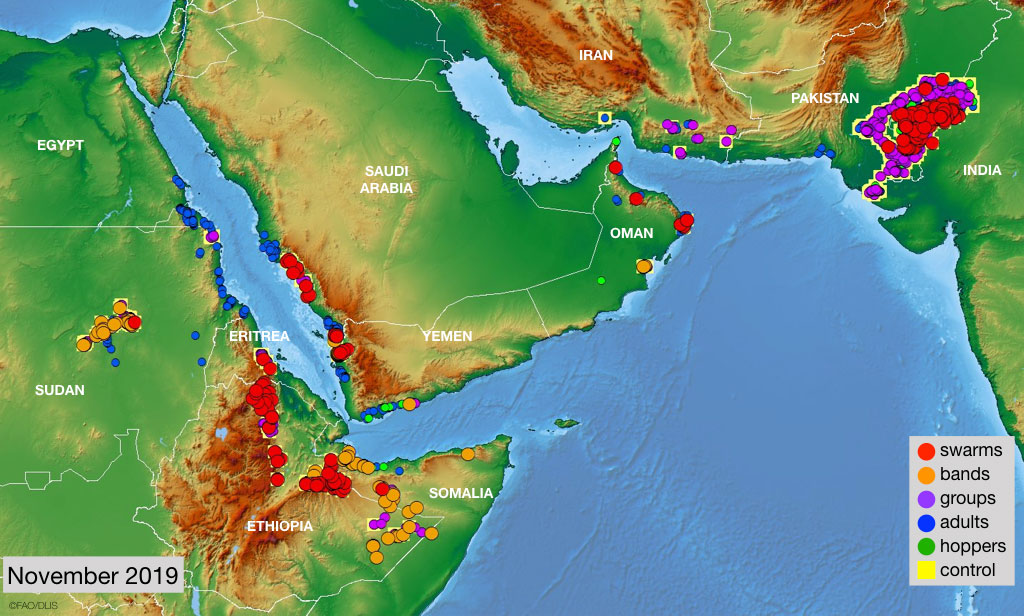
Current situation.
14 November. Situation remains serious along the Indo-Pakistan border and in the Horn of Africa
Control operations continue against groups of hoppers and adults, bands and swarms along both sides of the Indo-Pakistan border. Ground teams in India treated 13 028 ha during the first week of November in Rajasthan and the Kutch of Rann for a cumulative total of nearly 290 000 ha since the beginning of the summer. In Pakistan, 12 000 ha were treated on 1–10 November in Cholistan, Nara and Tharparkar deserts of which 400 ha were by air. Vegetation remains green in most places due to a late-ending monsoon.
Some groups and swarms have started to leave the summer breeding areas along the Indo-Pakistan border. On 10 November, a swarm flew over Karachi, Pakistan, moving from east to west. On the 12th, an immature swarm was seen on the northern coast of Oman while a mature swarm was reported in the northeast. Low numbers of mature adults were reported in Baluchistan of southwest Pakistan while small groups of immature and mature adults were seen during the first two weeks of the month at eight different places in adjacent areas of southeast Iran. More swarms are expected to form along both sides of the Indo-Pakistan border and move west towards Baluchistan in Pakistan and Iran. Some of the swarms may threaten agriculture areas in the Indus Valley of Pakistan.
In Ethiopia, the situation remains very serious in the northeast (Amhara, Tigray, Afar) and east (Dire Dawa, Somali, Oromia) where pasture and cropland edges are reported to be heavily infested with mid-instar hopper bands and fledglings that have formed at least a dozen immature swarms. New hatching continues in the Ogaden and immature swarms have been seen coming from adjacent areas in northern Somalia where hopper bands are forming on the northwest coast and plateau in areas of previously undetected breeding. Three DLCO-EA aircraft have been deployed in Ethiopia where some 3 000 ha were treated on 1–10 November of which 2 690 ha were by air. Breeding will continue in areas of recent rainfall in the Ogaden, causing more hopper band and swarms to form in the coming weeks. There remains a moderate to high risk that a few swarms may move southwards to reach northeast Kenya.
In Yemen, mid-instar hopper bands formed on the northern Red Sea coastal plains between Al Zuhrah and Suq Abs. Ground teams could only treat 570 ha due to a shortage of funds. The hoppers will fledge shortly, causing immature groups and small swarms to form. There is a risk that some of these populations may move into adjacent coastal areas of Saudi Arabia where small-scale breeding continues in a few places between Jizan and Lith. Breeding occurred on the southern coast, causing hopper bands to form.
In Sudan, a few mid-instar hopper bands were treated (700 ha) in the Rive Nile State in early November while low numbers of adults were seen in North Kordofan. As vegetation continues to dry out, a few small groups may form and move to the Red Sea coastal plains where scattered adults are already present in the Tokar Delta and in Wadi Oko/Diib in the northeast. In Eritrea, breeding is in progress on the Red Sea coast north of Massawa and hopper groups are forming. There is a risk that a few small swarms may appear from adjacent areas in northeastern Ethiopia.
Elsewhere, the situation remains calm.
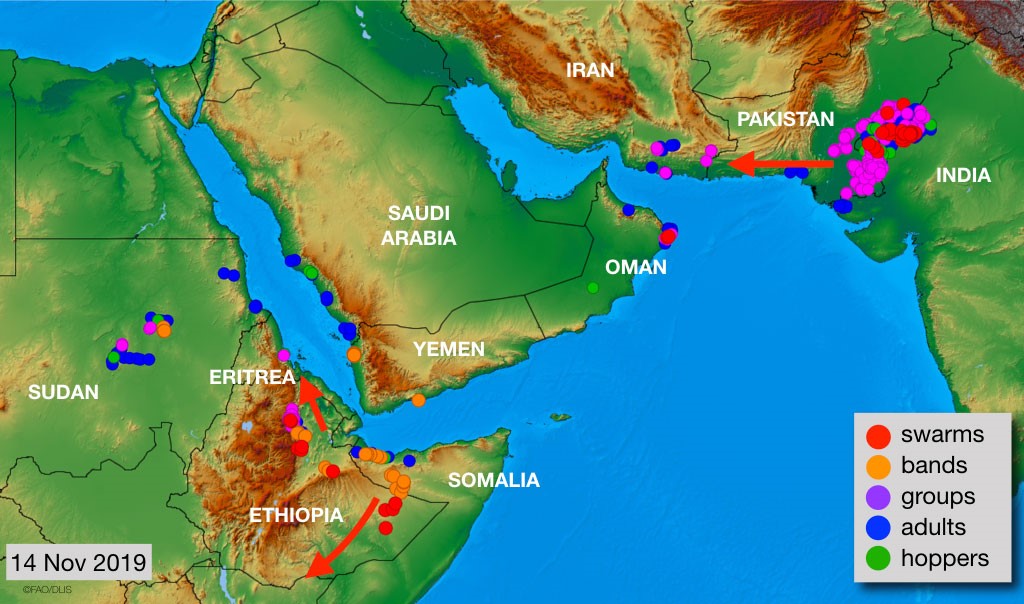
Current situation.
4 November. Serious situation continues in eastern and central regions
The current situation remains serious and threatening along the Indo-Pakistan border and in the Horn of Africa.
An increasing number of swarms formed during October in India and Pakistan where intensive control operations continued for a sixth consecutive month. It appears that some swarms have started to move west towards southwest Pakistan and southeast Iran where recent rains should allow them to survive until the spring. A few swarms may also reach northeast Oman on winds associated with Cyclone Kyarr in the first days of November.
Ground and aerial operations were in progress in northeast Ethiopia where swarms formed. A few groups moved north towards Eritrea while some swarms moved southeast to northern Somalia and eastern Ethiopia where they laid eggs that began hatching at the end of the month. There remains a moderate risk that a few swarms could reach northeast Kenya. A few hopper bands and small swarms formed in breeding areas on the Red Sea coast in Yemen and adjacent areas in Saudi Arabia, and control was undertaken. Breeding will continue along both sides of the Red Sea, which could be supplemented by the arrival of a few small swarms on the Eritrean coast from Ethiopia, causing a further increase in locust numbers.
In the Western Region, small-scale breeding occurred in Mauritania, Niger and southern Algeria, and isolated adults were present in Morocco and Libya. A few groups formed in northern Niger and limited control was carried out there and in Algeria. Locusts are expected to increase slightly in northwest Mauritania due to small-scale breeding.
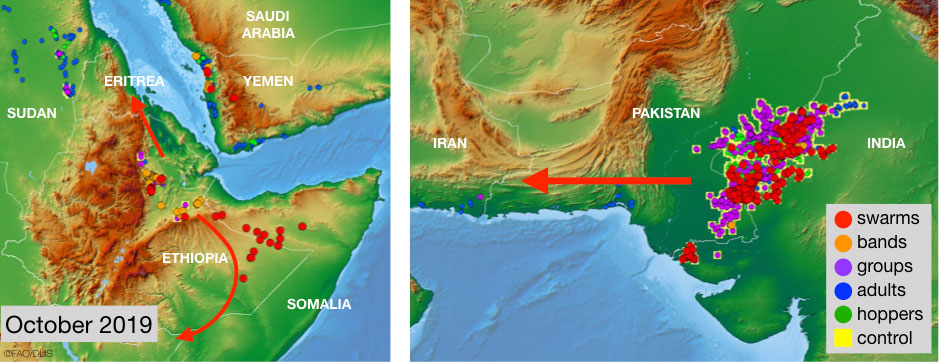
Current situation.
28 October. Desert Locust swarms on the move in India/Pakistan and Ethiopia
Immature and mature swarms that formed from recent breeding during the summer are moving into new areas in Pakistan and Ethiopia with the possibility of further migration.
In the Central Region, control operations are in progress against groups of hoppers and adults in the Afar region of northeast Ethiopia and along the railway area near Dire Dawa in the east. Adults are forming an increasing number of immature and mature swarms, some of which have already moved to the Ogaden area in eastern Ethiopia, perhaps supplemented by other undetected swarms from northern Somalia. This movement is expected to continue during the remainder of October and into November on two fronts: towards the southeast and the Ogaden that could lead to an invasion on northeast Kenya, and towards the north from Afar to Tigray and the western lowlands and highlands of Eritrea, reaching the Red Sea coastal plains in Eritrea and adjacent southern coastal areas in Sudan.
In Southwest Asia, swarms are forming in the summer breeding areas along both sides of the Indo-Pakistan border where substantial control operations continue in both countries. As conditions dry out, an increasing number of small swarms will move from east to west to the spring breeding areas in southwest Pakistan and southeast Iran. So far, swarms have been seen recently in the Las Bela area west of Karachi and gregarious adults were reported on the southeast coast of Iran and in the Pishin area near the border of Pakistan.
Cyclone Kyarr is currently forming in the northern Indian Ocean. During this week, Kyarr is predicted to move in a northwesterly direction towards the coast of northeast Oman, then southwest along the eastern coast. Strong northeasterly winds associated with the cyclone could carry a few swarms from the Indo-Pakistan border area to the northern and eastern coasts of Oman. There is a possibility that this movement could continue to eastern Yemen.
All affected-countries are urged to maintain a high state of vigilance, monitor the situation regularly by carrying out ground surveys, and undertake the necessary control operations whenever possible.
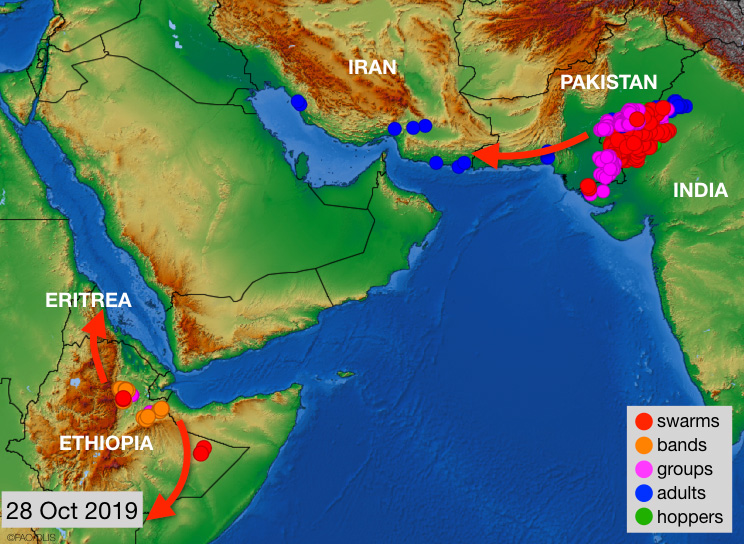
Current situation.
3 October. Situation remains threatening in eastern and central regions
The current Desert Locust situation has deteriorated in Ethiopia and remains serious in Yemen, Pakistan and India.
Swarms laid eggs in northeast Ethiopia that gave rise to hopper bands and aerial control operations were carried out (4 636 ha). Once new swarms form, there is a low risk that they could migrate south to the Ogaden in southeast Ethiopia and north to the Eritrean Red Sea coast where early breeding already started and should start in Sudan by November.
In the Eastern Region, ground control operations increased along both sides of the Indo-Pakistan border against swarms and a second generation of breeding that caused hopper groups and bands to form. India treated 84 639 ha in September while Pakistan treated 30 210 ha. As monsoon rains lasted longer than usual, infestations will persist in October. Any locusts that are not detected or controlled will form adult groups and small swarms that are expected to migrate in October and November west to southwest Pakistan and southeast Iran where rains are forecasted from October onwards. This would allow infestations to persist until temperatures warm up in the spring for breeding.
In the Central Region, hopper groups and bands formed on the Red Sea coast of Yemen and, to a lesser extent, in adjacent coastal areas of Saudi Arabia while breeding continued in the interior of Yemen. Control operations were undertaken in Saudi Arabia (4 195 ha) and in parts of Yemen (245 ha). Unusually good rains that fell in Yemen will allow breeding to continue, mostly unchecked, in the interior and on the coast, which will cause a substantial increase in locusts. Breeding may eventually occur in central Oman where heavy rains fell from Cyclone Hikka.
In the Western Region, locust numbers remained low in the northern Sahel of West Africa despite two generations of breeding in Chad. During October, adults are expected to concentrate and breed in northwest Mauritania where unusually good rains fell recently.
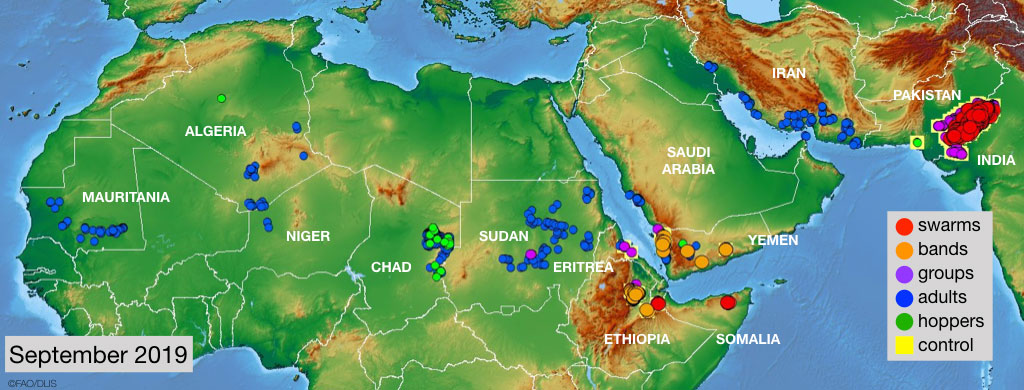
Current situation.
13 September. Serious situation persists in eastern and central regions
The current Desert Locust situation remains serious and worrisome in the Eastern and Central regions where good rains continue to fall and breeding is causing locust numbers to increase further.
In the Eastern Region, ground control operations are in progress along both sides of the Indo-Pakistan border against a second generation of breeding. So far this month, Pakistan has treated 9 200 ha of hopper and adult groups in Cholistan, Nara and Tharparkar deserts while India has treated 7 500 ha of hopper and adult groups as well as immature and mature swarms in West Rajasthan. Breeding is expected to continue in both countries through October.
In the Central Region, hoppers bands are present in the interior of Yemen south and east of Marib. More importantly, good rains have been falling in the winter breeding areas along the Red Sea coast since early August, which have caused ecological conditions to become favourable for breeding several months earlier than normal in Yemen, southwest Saudi Arabia and Eritrea. By early September, hatching had commenced, and hoppers are forming bands in Yemen and groups in Saudi Arabia and Eritrea. In addition, scattered adults appeared recently further north along the coast of Saudi Arabia near Lith. Saudi Arabia treated 900 ha and Eritrea 53 ha so far this month. Prevailing insecurity continues to restrict survey and control operations in Yemen.
In Ethiopia, several swarms were laying eggs in the highlands of northwest Afar near Amhara region and scattered adults are present in the railway area between Dire Dawa and Djibouti. Aerial control operations treated nearly 5 500 ha. During the last week of August, several swarms reportedly appeared on the plateau of northwest Somalia between Boroma and Burao that may have come from Yemen. High numbers of maturing adults may be present on the coast east of Berbera. In the northeast, groups of adults persisted on the plateau between Hadaftimo and Iskushuban.
Fortunately, locust numbers remain low in the summer breeding areas of the interior of Sudan where, despite good rainfall, only small-scale breeding is underway. Heavier rains fell in the western lowlands of Eritrea where breeding is expected to cause locust numbers to increase.
In the Western Region, the situation remains calm. Scattered adults are present in the northern Sahel of Chad and Mali, and probably in Niger and Mauritania as well. Locust numbers will increase slightly as a result of good rains that are in progress and small-scale breeding.
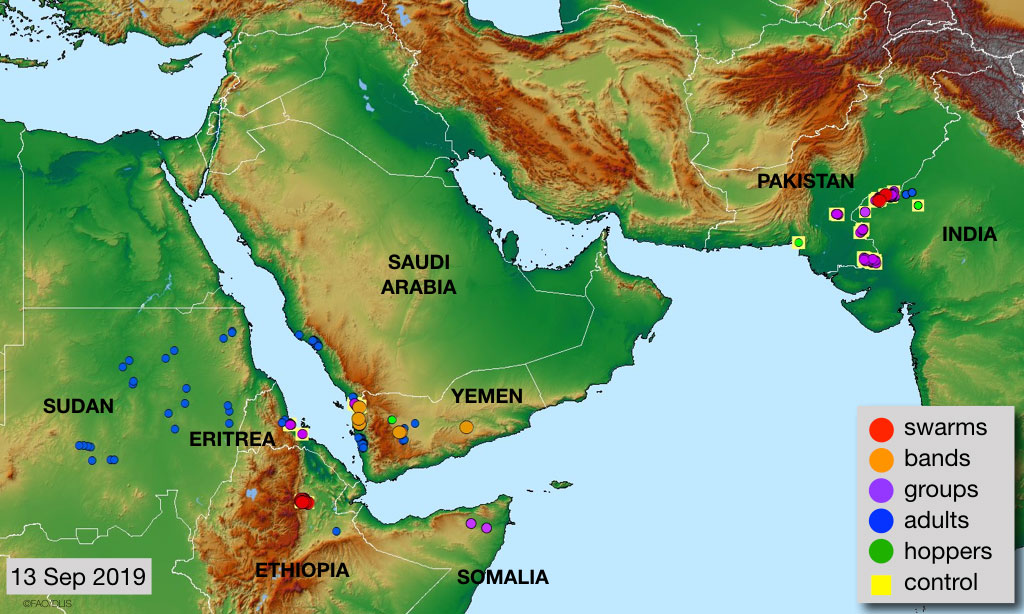
Current situation.
3 September. Worrisome situation in eastern and central regions
The current situation is most serious in Yemen, Pakistan and India, and it could deteriorate in Ethiopia and Eritrea.
In Yemen, swarms moved in the highlands and reached the Red Sea and Gulf of Aden coasts while a few swarms migrated through Djibouti and reached Ethiopia. Adult groups formed on the northwest coast of Somalia and moved to eastern Ethiopia. Unusually good rains fell along both sides of the Red Sea in Yemen, Saudi Arabia and Eritrea that will allow breeding from September onwards and hopper bands may form. A substantial increase in locust numbers is expected in Yemen as more swarms form in the interior and breeding starts in coastal areas. In northeast and eastern Ethiopia, breeding is expected to continue, giving rise to small hopper bands.
In Southwest Asia, swarm laying and widespread hatching caused numerous hopper groups to form in Rajasthan, India while a second generation of breeding occurred in Pakistan. Although ground control operations increased in both countries, there remains a risk of further breeding and the possible formation of new swarms starting in late September.
Smaller-scale breeding will occur in the northern Sahel between Mali and western Eritrea, causing locust numbers to increase slightly. Less breeding is expected in Mauritania due to poor rains so far. Breeding may also occur in southwest Libya.
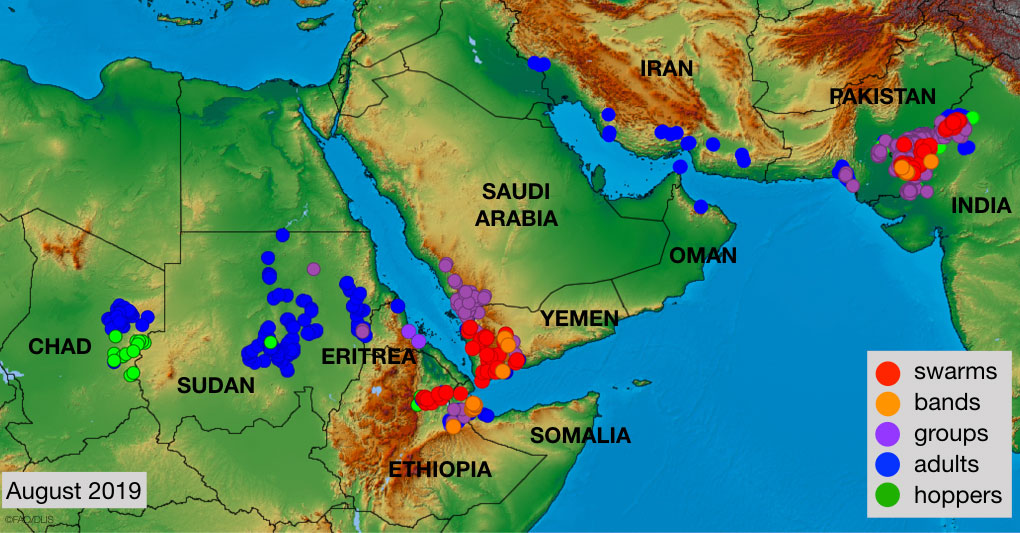
Current situation.
2 August. Swarms in India and Yemen with more expected
In Southwest Asia, substantial ground control operations are in progress against numerous spring-bred swarms that appeared in Rajasthan, India during July and laid eggs, which hatched and caused hopper groups and bands to form. Smaller operations are underway in adjacent areas of Pakistan. Locust numbers will increase further from widespread hatching in India and a second generation of breeding in Pakistan, giving rise to additional hopper bands in August and adult swarms in September.
In the Central Region, numerous hopper bands were present in Yemen and new swarms began forming after mid-July. Although control operations have been undertaken in some places, the situation is expected to deteriorate further and more swarms will form in the coming weeks. The unusually heavy rainfall and flooding that fell in July will allow another generation of breeding and further increases in locust numbers in Yemen, which could extend to the Red Sea coast in southwest Saudi Arabia. Last month, at least one swarm migrated from Yemen and reached southern Oman while other swarms arrived in northeast Somalia and probably laid eggs. A few hopper bands formed on the northwest coast of Somalia and small-scale breeding is underway in northeast Ethiopia where hopper groups and a few bands may form. In northern Sudan, adult groups were treated in the Nile Valley while low numbers of mature adults are appearing further south where small-scale breeding will cause locust numbers to increase in the traditional summer breeding areas of the country as well as in the western lowlands of Eritrea during August and September.
In the Western Region, the situation remains calm. Local breeding occurred in southwest Libya and in parts of Algeria during July, and is in progress in northern Niger. Low numbers of adults began appearing in southeast Mauritania. Small-scale breeding will occur during August and September in the northern Sahel between Mauritania and Chad, causing locust numbers to increase slightly.
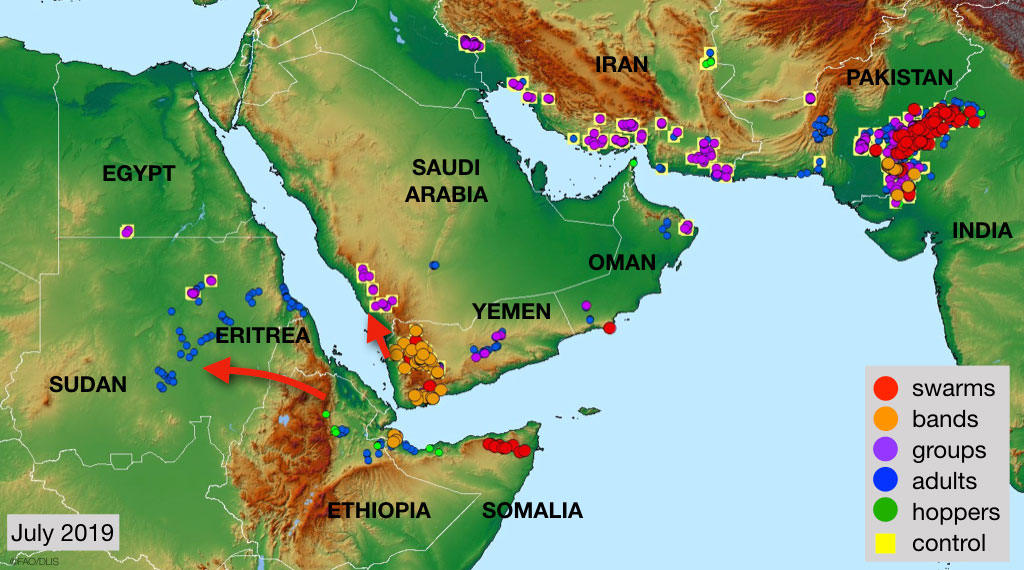
Current situation.
16 July. Serious Desert Locust situation in the Central and Eastern regions
Although spring breeding has come to an end and despite intensive control operations, several key summer breeding countries face a very serious Desert Locust threat now and in the coming months.
Yemen is the most concerned and at highest risk because of widespread hopper band infestations that will cause swarms to form later this month, which could give rise to another generation of breeding by the end of August if conditions remain favourable. Some ground control operations (500 ha) are underway but their impact against the overall infestations may be limited because not all areas can be accessed and capacities are limited. In addition, groups of adults are present in Wadi Hadhramaut where breeding may occur. In all, there could be a considerable increase in locust populations in Yemen during the summer that would threaten the region.
In the Horn of Africa, mature swarms were seen at several places in northeast Somalia during the past week, and crop damage was reported. Breeding is likely to occur along parts of the northern coast near Bosaso and Berbera that could cause hopper bands to form from late July onwards. Similar breeding is expected to occur in eastern Ethiopia while adult groups may appear in the northern region of Amhara as they move towards the summer breeding areas in western Eritrea and the interior of Sudan.
In Sudan, high numbers of adults are present along parts of the Nile Valley in the north. Scattered adults appeared recently on the Red Sea coast and also in North Kordofan where summer breeding will occur. A few residual swarms from spring breeding areas in Arabia may arrive in these areas by the end of this month and lay eggs.
In India, ground control operations (12 000 ha) are in progress against a number of mature adult groups and swarms that appeared this month in Rajasthan and along the border with Pakistan where they are laying eggs. Similar operations (4 000 ha) are underway against groups of mature adults that are laying in adjacent areas of Tharparkar and Cholistan deserts in Pakistan. Hatching and band formation will occur in both countries during the remainder of July. A second generation of breeding could start as soon as mid-August south of Rohri near the Indus Valley in Pakistan where early breeding occurred in May. The scale and extent of the summer breeding in both countries will depend on this year's monsoon rains, which are so far about two weeks late in arriving to the breeding areas along both sides of the border.
The current Desert Locust situation developed from two cyclones in May and October 2018 that brought unusually heavy rains to a large and remote area in the Empty Quarter of eastern Saudi Arabia that borders Yemen and Oman. Three generations of undetected breeding gave rise to substantial swarms earlier this year that moved to Yemen, Saudi Arabia and Iran. Intensive ground and aerial control operations were mounted in Saudi Arabia (219 000 ha) and Iran (708 000 ha) that undoubtedly reduced locust populations but could not entirely prevent swarms from forming and moving to the summer breeding areas. Residual infestations of adult groups remain in a few places of Iran while a few swarms migrated last month from Yemen to northern Somalia and Ethiopia.
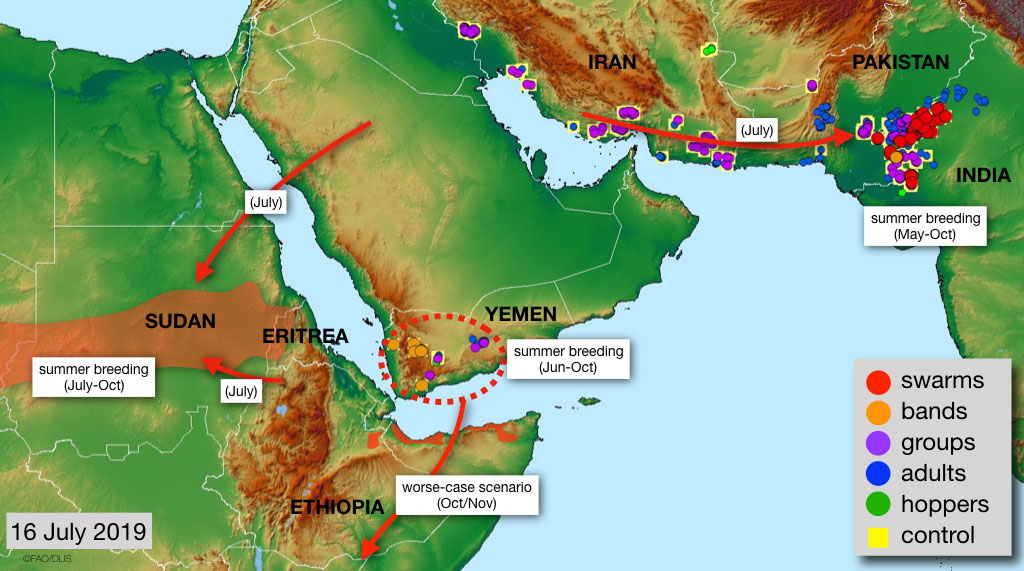
Current situation.
4 July. Spring breeding declines but swarms appear in the Horn of Africa
Spring-bred infestations in Iran, Saudi Arabia and Pakistan declined during June due to drying conditions, increasing temperatures, and intensive control operations that treated more than 300 000 ha. However, locusts increased along the Indo-Pakistan border as early summer breeding continued and several swarms arrived in Rajasthan to lay eggs. Control operations were undertaken in both countries.
Numerous mature swarms were seen in Yemen where some remained to lay eggs while others crossed the sea to northern Somalia, southern Eritrea and eastern Ethiopia. Some of these swarms could continue moving to the interior of Sudan while others could breed on the northern Somalia coast, in eastern Ethiopia, and on the Red Sea coast in Yemen and adjacent areas in Saudi Arabia because all of these areas received good rainfall in June.
There remains a moderate risk that small spring-bred swarms may have escaped detection and control in the Arabian Peninsula and could arrive in the summer breeding areas of Sudan to lay eggs during July. Groups of mature adults appeared in the Western Desert of Egypt at the end of June.
This year’s summer breeding is anticipated to be heavier than normal, resulting in hopper bands and perhaps small swarms developing in several key areas: (a) along the Indo-Pakistan border where two generations may be possible, (b) in Yemen where survey and control operations remain limited, (c) in areas of recent rainfall in Ethiopia and northern Somalia, and (d) in the traditional summer breeding areas in the interior of Sudan. In contrast, only small-scale breeding is expected this summer in the northern Sahel of West Africa between Mauritania and Chad.
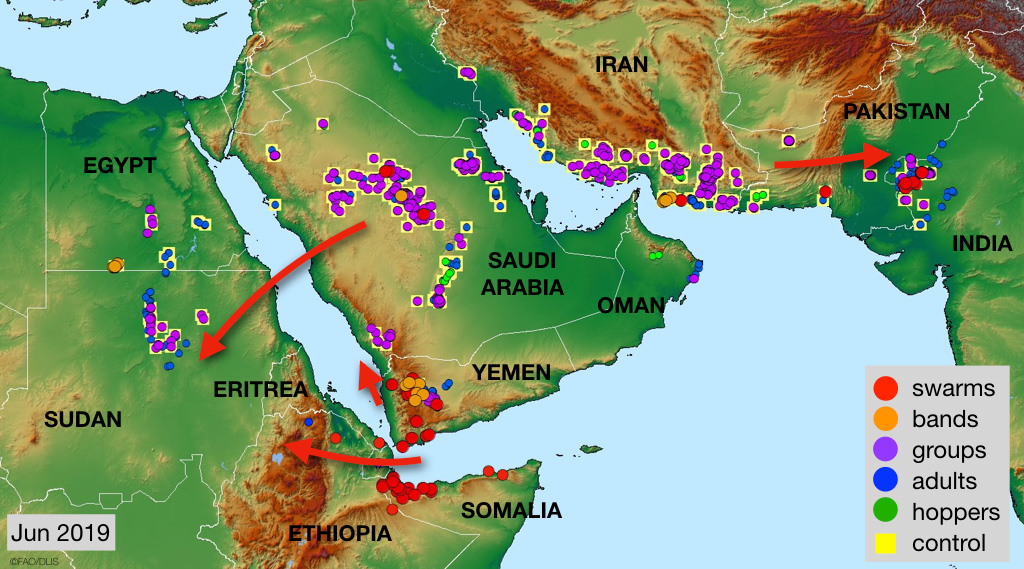
Current situation.
Although control operations have treated nearly 200 000 ha so far this month, all countries should remain vigilant and be prepared for any swarms that might arrive in Sudan and along the Indo-Pakistan border where higher than normal breeding is expected during the summer months.
In Saudi Arabia, ground and aerial control operations continue against numerous groups of immature and mature adults and a few remaining hopper groups and bands in the interior between Riyadh and Hail, and near Tabuk, Wadi Dawasir, Abha and south of Kuwait. Teams treated 36 580 ha on 1-15 June. Infestations are expected to decline due to dry conditions and control. Small swarms could form and move to Sudan, Yemen and perhaps the Indo-Pakistan border.
In Yemen, hatching and the formation of hopper groups and bands have commenced in the interior where egg-laying continues between Marib and Al Hazm and near Bayhan. Numerous mature swarms were seen in the past few days throughout the central highlands as well as on the southern coast near Aden where at least one laid eggs. More egg-laying, hatching and hopper band formation will occur in the interior, in some areas on the coast near Aden and probably on the northern Red Sea coast.
In Iran, intensive ground and aerial control operations continue against spring-bred hopper groups, immature and mature adult groups and one swarm mainly in the southern provinces of Bushehr, Hormozgan, southern Kerman and Sistan-Baluchistan. Teams treated 151 250 ha on 1-15 June. As vegetation dries out, more groups of immature adults and perhaps a few small swarms are expected to form in the coming weeks and move to the Indo-Pakistan border area.
In Pakistan, ground control operations continue in spring breeding areas of Baluchistan against hopper groups in the interior (Dalbandin) and near the coast in Turbat, Gwadar and Lasbela. Similar operations are in progress against hoppper and adult groups in a few summer areas of Nara and Cholistan deserts. Teams treated 4 625 ha on 1-15 June. Adult groups will move from Baluchistan to the summer breeding areas along the Indo-Pakistan border where more hatching and the formation of hopper groups will occur.
In India, ground control operations are in progress against first to third instar hoppers and groups in Jaisalmer district of Rajasthan. Teams treated 1 707 ha on 1-15 June. More hatching and the formation of hopper groups are expected in the coming weeks in Rajasthan, which may be supplemented by groups of adults and perhaps a few small swarms arriving from spring breeding areas.
In Sudan, ground teams treated 3 700 ha of immature and mature adult groups in the Nile Valley between Abu Hamd and Dongola on 1-18 June. Breeding is underway in a few areas and hatching is expected to cause hoppers to form small groups. Scattered immature and mature adults were seen further south in the Baiyuda Desert towards the summer breeding areas where small swarms could arrive from Saudi Arabia and lay in areas of recent rains.
In Egypt, limited ground control (354 ha) was carried out against scattered mature adults in the Western Desert near Baris and Tushka and near Aswan on 1-11 June.
The Western Region is not threatened although a few small swarms may reach eastern Chad.
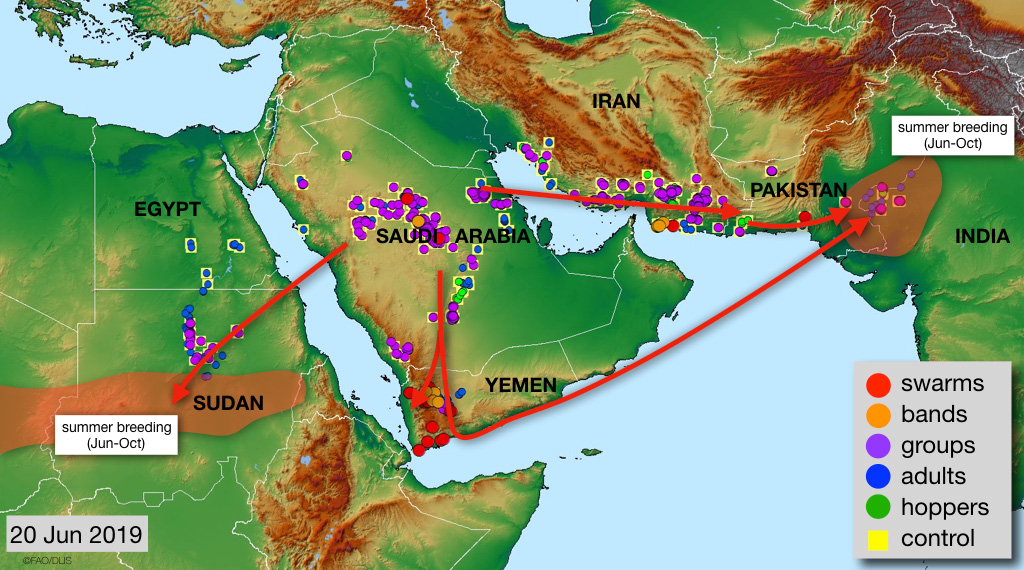
Current situation.
13 June. High risk of migration from spring to summer breeding areas where early rains have started
While spring breeding is declining in all areas due to control operations and drying conditions, there is a high risk of residual populations migrating to summer breeding areas. Extreme vigilance and preparedness are required.
In Iran, intensive ground and aerial control operations continue against late instar hopper groups, a few hopper bands, groups of mature adults, and immature and mature adults mainly on the coast of Bushehr, Hormozgan and Sistan Baluchistan as well as in the interior of Sistan Baluchistan. Teams treated 78 650 ha on 1-6 June. As vegetation dries out, more groups of immature adults and perhaps a few small swarms are expected to form in the coming weeks and move to the Indo-Pakistan border area.
In Pakistan, late spring breeding continues in a few interior and coastal places of Baluchistan where mid to late instar hopper groups are present and fledging and immature adult groups are forming. On 1 June, a copulating swarm was seen north of Uthal. Early breeding commenced along the Indo-Pakistan border in Nara Desert south of Khairpur where mature adult groups and hopper groups of all instars are present, and in Cholistan east of Rahimyar Khan where mature adults and early instar hopper groups are present. Control operations treated 1 495 ha on 1-9 June. In the coming weeks, groups of immature adults will form and leave the spring breeding areas of Baluchistan, moving to the summer breeding areas along the Indo-Pakistan border where more hatching and the formation of hopper groups will occur.
In India, groups of adults continue to lay eggs in West Rajasthan between Sam and Phalodi. Hatching commenced and early instar hoppers are forming groups. Control operations treated 1 340 ha on 1-10 June. More hatching and the formation of hopper groups are expected in the coming weeks, which may be supplemented by groups of adults and perhaps a few small swarms arriving from spring breeding areas.
Tropical Cyclone 02A (Vayu) is expected to move off the Gujarat coast of northwest India, which could bring good rains to the summer breeding areas further inland in Gujarat and southern Rajasthan as well as adjacent areas of Tharparkar Desert in Sindh, Pakistan during the coming days.
In Saudi Arabia, spring breeding has nearly ended in the interior except for a few places on the western edge of the Empty Quarter. Ground and aerial control operations continue against mainly groups of immature and mature adults and a few remaining hopper groups and bands, treating nearly 21 000 ha on 1-7 June.
In Yemen, adult groups are laying eggs in the interior south of Marib. Mature swarms were seen in the past few days in the highlands near Sana'a and there was one report of mature swarm nearly reaching Suq Abs on the northern Red Sea coast. Control operations are not possible. Some adult groups and swarms are likely to remain in the interior and perhaps on the Red Sea coast and breed while others could move to the Indo-Pakistan border.
In Sudan, groups of immature and mature adults are present in the Nile Valley of Northern and River Nile States between Abu Hamed and the Egypt border. Control operations are in progress. Most of these groups are likely to move south to the summer breeding areas of Darfur and Kordofan where they will lay eggs in areas that have already received early rains since the Inter-Tropical Convergence Zone (ITCZ) is more than 200 km further north than usual. They are likely to be supplemented by a few small swarms arriving from Arabia.
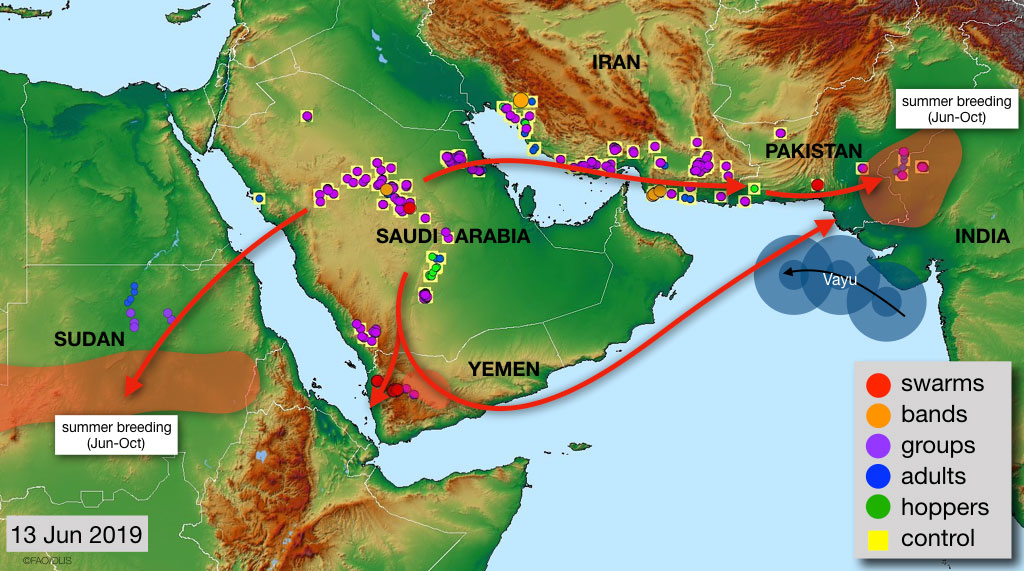
Current situation.
5 June. Spring-bred locust infestations threaten summer areas
Intensive ground and aerial control operations continued during May against widespread infestations of hopper and adult groups, bands and swarms in Saudi Arabia and Iran that developed from two generations of unprecedented spring breeding. Swarms moved from eastern Yemen into the central highlands and a few continued into southern Saudi Arabia. A few swarms moved to southern Jordan during a brief period of unusual southerly winds while hopper bands and immature adult groups were present along the Kuwait / Saudi Arabia border. Winter-bred immature adult groups persisted on the northern Red Sea coast of Saudi Arabia and the coast in southeast Egypt. At the end of May, adult groups appeared in the interior along both sides of the Egypt/Sudan border.
While the control operations have reduced locust infestations in the spring breeding areas, populations that are not detected or cannot be treated will form groups and small swarms that will move to summer breeding areas in the interior of Sudan and Yemen, and along the Indo-Pakistan border during June. As rains have occurred some six weeks earlier than normal in these areas, breeding could commence by the end of this month. Depending on the summer rains, two generations of breeding may be possible this year, causing a further increase in locust numbers by October.
Very little breeding occurred in Northwest Africa this spring so locust numbers are currently very low and will remain so. Summer breeding may start earlier than normal this year in Niger and Chad because of the May rains.
All efforts should be undertaken to control the current situation and be prepared for the summer.
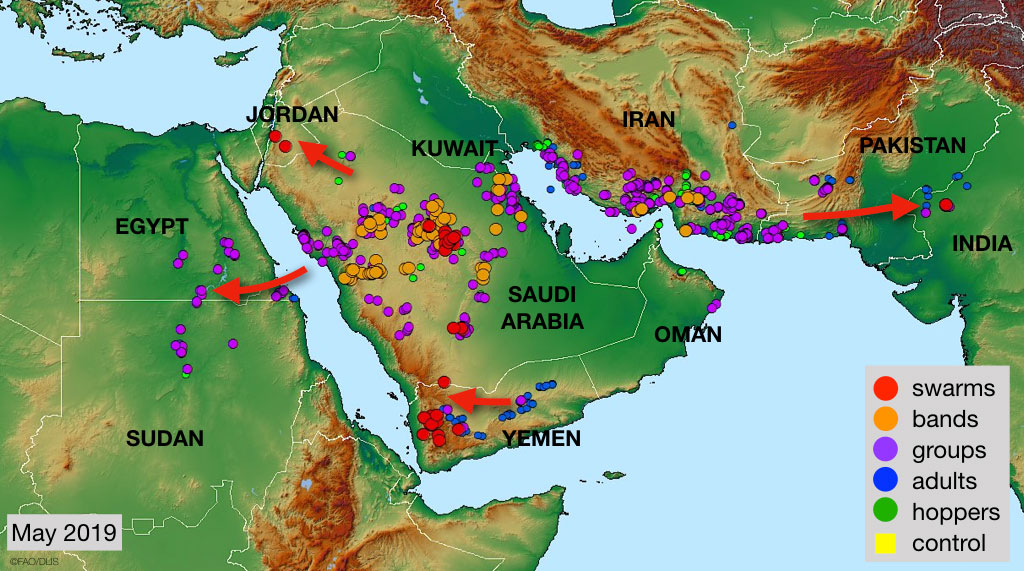
Current situation.
14 May. A second generation of spring breeding is underway in Saudi Arabia and Iran
As a result of unusually good ecological conditions, a second generation of breeding is expected to cause a further increase of locusts in the spring breeding areas of Saudi Arabia and Iran.
In Saudi Arabia, spring breeding started earlier than normal this year and is also more distributed throughout the interior: along the eastern side of the Asir Mountains (March–present), in central areas between Riyadh and Hail (February–present), in the northeast between Jubail and Kuwait (March–present), and along the western edge of the Empty Quarter between Wadi Dawasir and Riyadh (April–present). A second generation of breeding is underway in central areas with egg-laying in the last week of April and hatching that may have already started. Ground and aerial teams treated 16,430 ha on 1-10 May.
In Kuwait, late instar hopper groups and bands were seen near Al Wafra and the Saudi Arabia border since the last week of April. Many of these started to fledge about a week ago and are likely to form groups of immature adults and perhaps a small swarm if not controlled. The infestations are likely to have originated from breeding that occurred in March along inaccessible border areas by swarms that moved enroute from Saudi Arabia to the southern coast of Iran. Control operations have treated 50 ha since 28 April. A few swarms may also appear from adjacent areas of Saudi Arabia.
In Jordan, an immature swarm arrived in the south near Al Jafr on 4 May that was controlled the next day. On 5 May, another immature swarm flew over the same area and reached Tafilah (south of Amman) where it was treated by air. In all, control operations treated 460 ha. The swarms are likely to have originated from breeding areas in Saudi Arabia and migrated during a brief period of southerly winds. A few more swarms could appear during periods of southerly winds, and perhaps reach southern areas of Syria or Israel.
In Yemen, locals reported several immature and mature swarms moving in the highlands between Dhamer and north of Sana'a during the past week. These swarms originated from breeding several months ago in the Empty Quarter. A ground survey is underway in the interior between Marib, Ataq and Shabwah where so far scattered adults and a few groups have been seen. Egg-laying is in progress in a few areas, and hatching is likely by the end of May with hopper groups and small bands forming in June.
In Iran, hopper and adult groups and a few hopper bands are present along parts of the coast from west of Bandar Lengeh to the Pakistan border and in the Jaz Murian Basin of the interior. A second generation of spring breeding started in late April with substantial hatching this past week that will cause more hopper groups and bands to form, which could give rise to new adult groups and swarms starting about mid-June if not controlled. Intensive control operations treated more than 18,000 ha so far in May. There is a risk that a few adult groups or small swarms could appear from Arabia at times.
In Pakistan, small-scale breeding continues in coastal areas of Baluchistan where limited control was carried out against a few hopper groups. Hoppers will start to fledge and become immature adults at the end of May and continue to about mid-June. At that time, local infestations could be supplemented by adult groups and small swarms arriving from Iran.
The longer-term outlook suggests that there is a moderate risk of a few swarms migrating after mid-June from the spring breeding areas to the summer breeding areas along both sides of the Indo-Pakistan border and also the interior of Sudan. The scale of the migration depends on the success of current survey and control operations. Therefore, all affected-countries should maintain these operations and report on time. FAO DLIS will continue to monitor the situation closely and keep all countries informed.
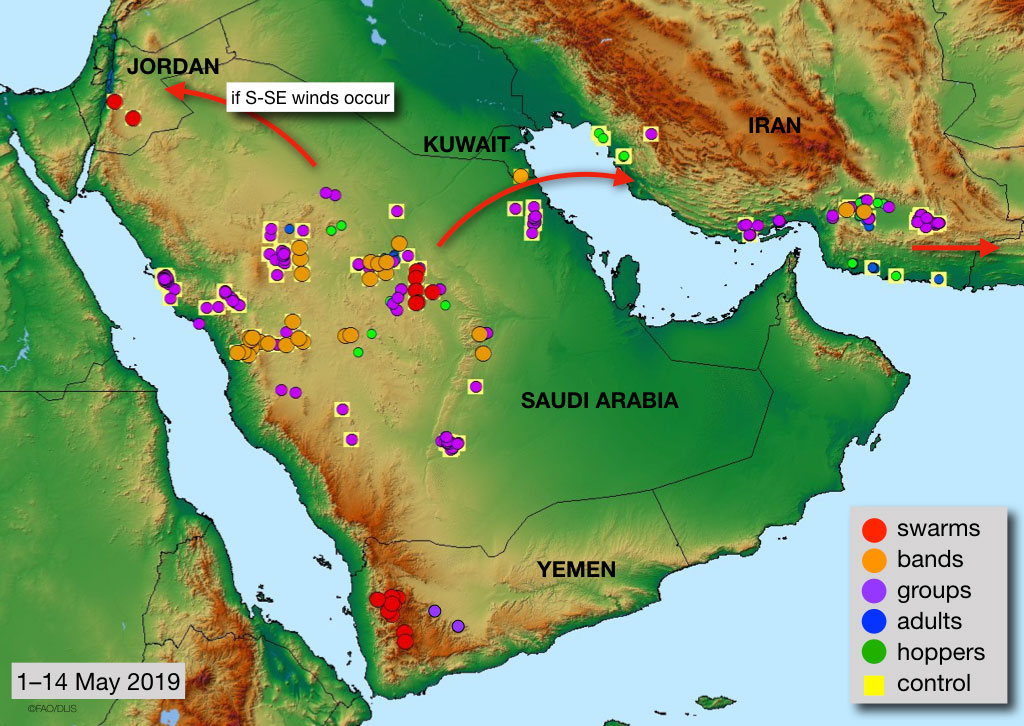
Current situation.
3 May. Locust infestations increase in spring breeding areas of Iran and Arabia
During the past few weeks, the Desert Locust situation has intensified in the traditional spring breeding areas of Iran and Saudi Arabia.
In Iran, substantial aerial and ground control operations carried out by national authorities treated more than 86 000 during April as breeding continued for a third consecutive month within a large portion of the south, giving rise to groups of hoppers and adults, hopper bands and a few swarms. Smaller-scale breeding occurred in adjacent areas of southwest Pakistan and control was undertaken. Breeding will continue in both countries and more hopper bands and a few small swarms are likely to form. There is a moderate risk that adult groups and perhaps a few small swarms will move this year towards the Indo-Pakistan summer breeding areas in about mid-June, depending on control operations and the weather in currently infested areas.
In Saudi Arabia, spring breeding commenced in the interior where hoppers are forming groups and bands. Aerial and ground teams treated more than 27 000 ha during April in the interior as well as on the Red Sea coast where winter breeding has ended. In Yemen, swarms formed from earlier breeding in the southern Empty Quarter and are moving throughout the interior of the country where survey and control operations were not possible, so locals were catching and eating locusts. Several swarms moved to Najran, Saudi Arabia in the past few days. A few small adult groups moved from eastern Yemen to northern Oman where they laid eggs in April and limited control operations were conducted. Small-scale breeding is expected to continue in Oman. In Yemen, hatching will cause locust numbers to increase significantly in the interior where hopper bands are expected to form.
Elsewhere local breeding occurred in northwest Mauritania where control was undertaken last month. Breeding is underway in eastern Algeria, but the situation is expected to remain calm.
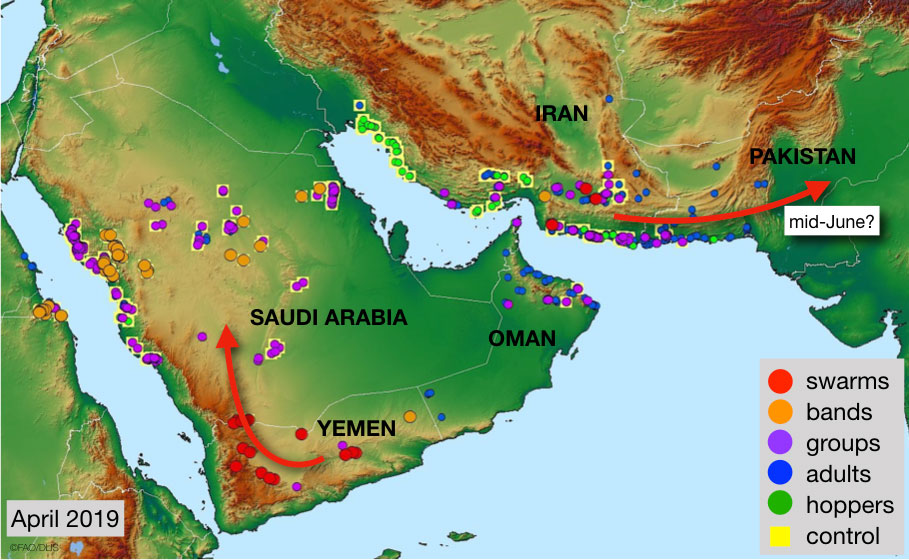
Current situation.
24 April. Locusts increasing in spring breeding areas of Southwest Asia and Arabia
Desert Locust breeding is underway in the traditional spring breeding areas in southeast Iran, southwest Pakistan and in the interior of Saudi Arabia.
In Iran, groups of adults first arrived on the southern coast in late January from the Arabian Peninsula, about a week after FAO DLIS issued a warning. Additional groups and swarms appeared in February and March, spreading eastwards along the coast where they laid eggs that began to hatch from mid-March onwards. The hoppers formed small groups and a few bands. Although control operations were immediately launched, breeding has continued because of good rains and favourable ecological conditions. Currently, hoppers, adults and groups of hoppers and mature adults are primarily present on the southeast coast between Jask and Chabahar and in the Jaz Murian Basin of the interior. Smaller infestations are present further west along the coast and in interior areas near Bander-e Lengheh. Reports indicate that nearly 12 000 ha have been treated since February.
In Pakistan, a small swarm first appeared on the southwest coast in mid-March followed by several groups of adults that laid eggs. Hatching started in early April, causing small groups of hoppers to form. Control teams have treated more than 600 ha so far. Low numbers of mature solitarious adults are present in the interior of Baluchistan where breeding is expected.
In Saudi Arabia, a second generation of breeding is coming to an end in the winter areas along the Red Sea coast while a first generation of breeding has started in the spring areas of the interior where groups of adults laid eggs between Gassim and Hail. Aerial and ground teams have treated more than 76 000 ha so far this year.
In Yemen, several swarms and adult groups have appeared in Wadi Hadhramaut and moved further west in the interior to Marib and Al Jawf in recent days. These populations originated from several generations of breeding that occurred in the Empty Quarter near the border of Yemen, Oman and Saudi Arabia where two cyclones gave rise to exceptional breeding conditions from last summer to early this year. In the past few days, a few groups of mature adults moved out of this same area and were seen in the interior of northern Oman where good rains fell recently.
During April and May, breeding will continue in southeast Iran, southwest Pakistan and the interior of Saudi Arabia. Breeding is expected to commence in the interior of Yemen and, to a lesser extent, in northern Oman. Consequently, locust numbers are expected to increase further, especially in Yemen where it is difficult to carry out survey and control. Surveys should be maintained in all areas and control operations undertaken as necessary to reduce the scale of the breeding and any eventual migration to summer breeding areas along the Indo-Pakistan border and the interior of Sudan.
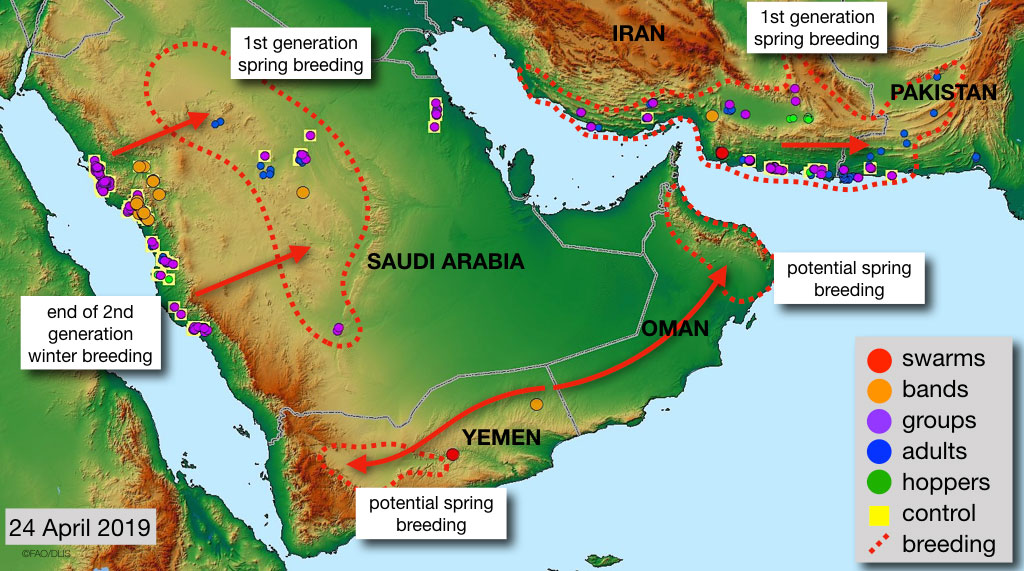
Current situation.
3 April. Spring breeding expected as situation improves on the Red Sea coast
The Desert Locust situation is improving along both sides of the Red Sea as a result of intensive control operations that treated more than 80 000 ha during March and due to drying conditions.
Nevertheless, second-generation breeding is still in progress in some coastal areas of Sudan and Saudi Arabia where ecological conditions remain favourable, causing additional hopper and adult groups, bands and a few swarms to form. Some adult groups moved to the spring breeding areas in the interior of Saudi Arabia and laid eggs in March.
In southwest Asia, adult groups and a few swarms are breeding on the southern coast of Iran and hatching commenced at the end of March. Adult groups and at least one swarm appeared in adjacent areas of southwest Pakistan in mid-March where they laid eggs. Control operations were in progress in both countries.
During April, locust numbers will decline along both sides of the Red Sea but will increase in the spring breeding areas in the interior of Saudi Arabia, and coastal and interior areas of southern Iran and southwest Pakistan where hatching will occur and hopper groups and bands are expected to form. Some of these could eventually form adult groups and perhaps a few small swarms by late May. Adults groups may also appear in the Nile Valley in northern Sudan and breed near cropping areas.
In northwest Africa, smaller-scale breeding will occur in areas south of the Atlas Mountains in Morocco and Algeria that receive rainfall.
All countries should remain vigilant and undertake control operations whenever necessary.
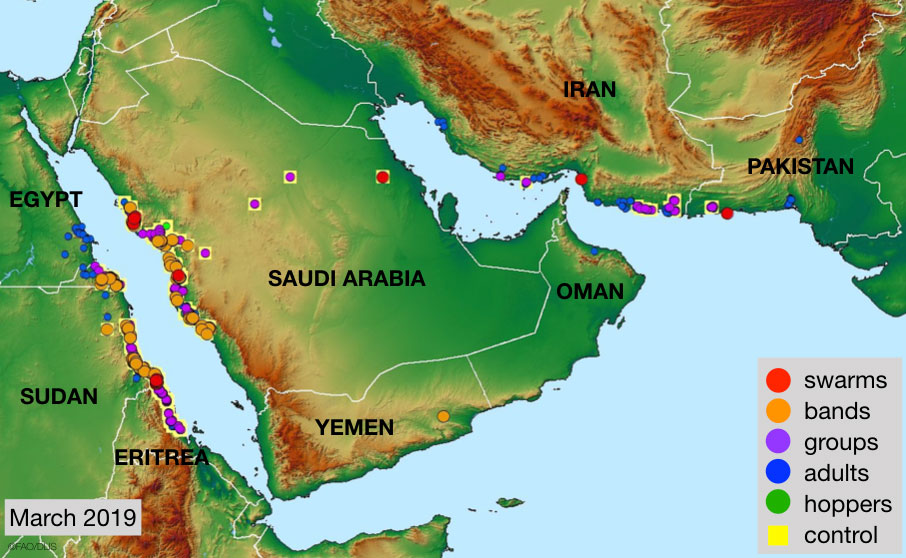
Current situation.
4 March. Situation improving on the Red Sea coast but potential threat remains
The Desert Locust situation began improving in late February on the Red Sea coast as infestations declined in some areas due to intensive control operations that treated 80 000 ha in February and because of drying conditions.
Control operations are still in progress against second-generation breeding along the Red Sea coast in Sudan, Egypt, Saudi Arabia and, to a lesser extent, Eritrea. There is a potential risk that any infestations that are not detected or could not be treated will form additional groups of hoppers and adults, bands and some small swarms as vegetation dries out further in March. Most of these populations are expected to migrate to spring breeding areas in the interior of Saudi Arabia while some could move to the Nile Valley in northern Sudan. As one generation of breeding is expected to occur in these areas between March and June, intensive monitoring and control efforts will be required by the affected countries.
Breeding continues in eastern Yemen on the edge of the Empty Quarter in areas that received good rain from cyclones Mekunu and Luban in May and October respectively. From there, adults and at least one swarm have moved to cropping areas in Wadi Hadhramaut. As vegetation dries out in eastern Yemen, additional populations are expected to arrive in Hadhramaut and central interior areas, and breed if rains fall.
In southwest Asia, control operations are in progress against adult groups and a few small swarms that were laying eggs along the southern coast of Iran in February. Breeding will continue, causing locust numbers to increase during the spring.
The situation remains calm in West and Northwest Africa.
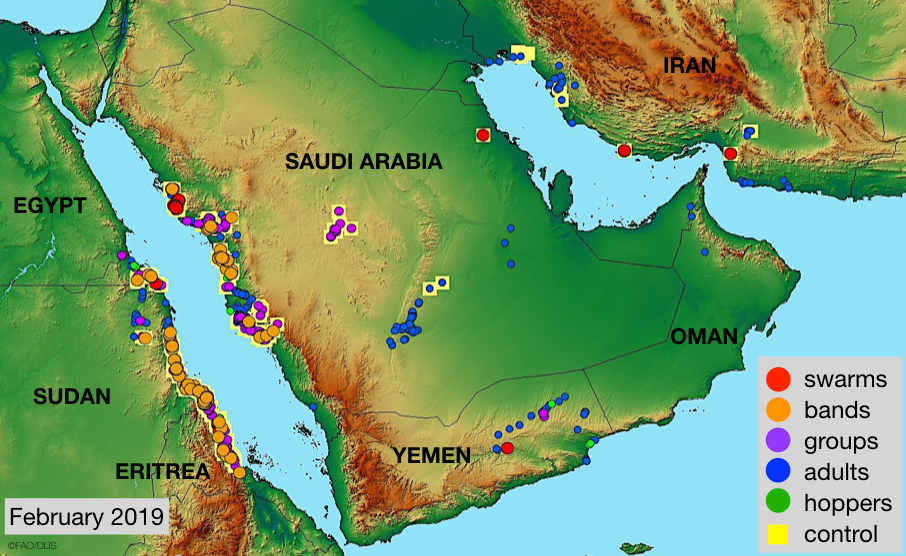
Current situation.
15 February. Control operations continue against Desert Locust outbreak along Red Sea coast
Ground and aerial control operations are in progress as a result of a Desert Locust outbreak that developed on the Red Sea coast of Sudan and Eritrea during December. A second generation of breeding by adult groups and swarms continues in these areas as well as on the coast in southeast Egypt and on the central and northern coast is Saudi Arabia. Consequently, locust numbers are increasing along both sides of the Red Sea.
In the past two weeks, there has been an escalation in second-generation hatching and hopper band formation on the north coast of Saudi Arabia between Thuwal and Masturah, on the central coast near Lith, on the southern coast of Sudan near the Eritrean border, and on the central coast of Eritrea. New swarms are likely to start forming at the end of the month in some places.
In the interior of Saudi Arabia, groups of mature adults have reached the spring breeding areas between Zalim and Gassim where some of them have started to lay eggs. Immature adults are maturing along the western and northern edge of the Empty Quarter near Wadi Dawasir and southeast of Riyadh.
Control operations have treated nearly 85 000 ha since December of which 30 000 ha were treated in the past two weeks in Egypt, Eritrea, Saudi Arabia and Sudan.
Since the beginning of February, moderate rains have fallen on the northern Red Sea coast in Saudi Arabia between Yendo and Al Wajh while light showers fell on the central coast near Qunfidah. As vegetation is still green in coastal areas along both sides of the Red Sea, breeding will continue, causing a further increase in hopper and adult groups, bands and swarms. Once vegetation begins to dry out, adult groups and a few swarms are likely to move north along the Red Sea coast in Eritrea to Sudan, and from the Red Sea coast of Sudan to the Nile Valley in northern Sudan. There is a moderate risk that some swarms could cross the Red Sea to the coastal and interior areas of Saudi Arabia.
In Iran, control operations are underway against at least one swarm that arrived on the southern coast at the end of January as well as against adult infestations in the spring breeding areas of the interior in the Jaz Murian Basin. Hatching and band formation are expected to occur in these areas by the end of February.
All affected countries should step up vigilance and control measures to reduce current infestations and lessen the risk of migration and spring breeding.
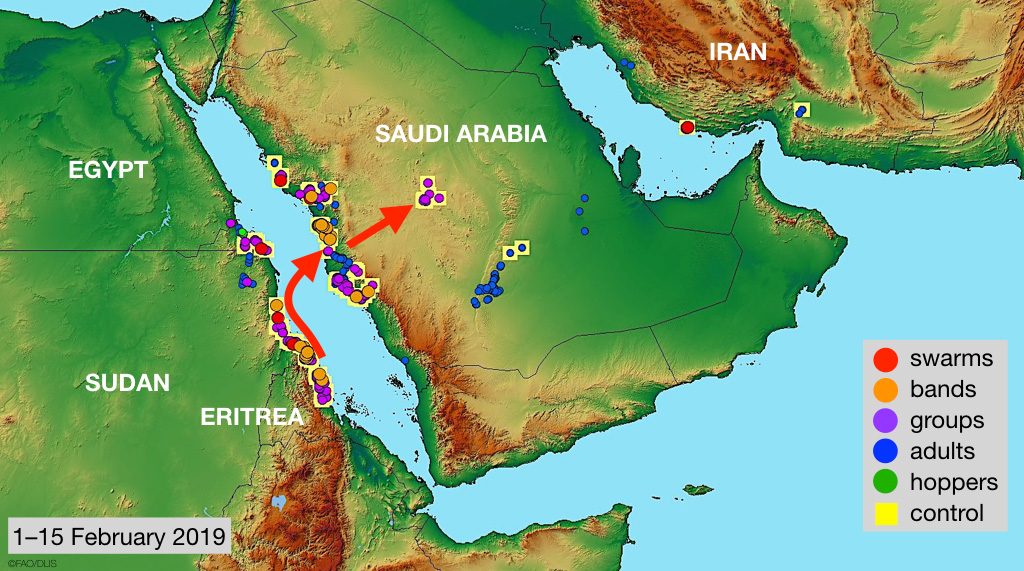
Current situation.
4 February. Swarms form and migrate in Central Region
A Desert Locust outbreak is in progress on the Red Sea coastal plains of Sudan and Eritrea where an increasing number of groups, bands and swarms formed during January as a result of a second generation of breeding.
In addition to the breeding, there were swarm migrations originating from two different sources. At least one winter-bred mature swarm crossed the Red Sea from the Sudan/Eritrea outbreak area to the northern coast of Saudi Arabia at mid-month, followed by additional migrations about one week later. Mature adult groups and a swarm arrived on the Red Sea coastal plains in southeast Egypt from the south at the end of the month. In the interior of Saudi Arabia, immature swarms invaded the western and northern edges of the Empty Quarter, coming from the southeastern Empty Quarter near the Yemen/Oman border where two generations of breeding occurred after good rain from cyclones Mekunu (May) and Luban (October). A few of these swarms moved to UAE and southern Iran. Adult groups could continue to move east along the southern coast of Iran to southwest Pakistan.
Aerial operations were mounted in Sudan and Saudi Arabia supplemented by ground control in both countries, Eritrea and Egypt, treating nearly 55,000 ha during January.
Breeding will continue during February on the Red Sea coast in Sudan and Eritrea, causing a further increase in hopper and adult groups, bands and swarms. As vegetation dries out, adult groups and a few swarms are likely to move north along the Red Sea coast in Eritrea to Sudan, and from the Red Sea coast of Sudan to the Nile Valley in northern Sudan. There is a moderate risk that some swarms could cross the Red Sea to the coastal and interior areas of Saudi Arabia.
In Northwest Africa, the situation remains calm. Local breeding occurred last month in northwest Mauritania and southern Algeria. If rains fall, spring breeding is likely to commence in March along the southern side of the Atlas Mountains in Morocco and Algeria.

Desert Locust outbreak.
18 January. Second generation breeding starts in Sudan/Eritrea outbreak
Groups of late instar hoppers, immature and mature adults are present on the Red Sea coastal plains between Port Sudan to Massawa, Eritrea. A small mature swarm reportedly moved south along the coast towards Massawa earlier this week, reaching Foro on the 13th. A second generation of breeding is in progress with reports of new gregarious hatchlings forming small groups in Eritrea. Ground control operations are underway in both countries. As ecological conditions remain favourable, additional laying and hatching are expected during the remainder of January. Thereafter, breeding is likely to decline based on current rainfall forecasts. Elsewhere, breeding is likely to be in progress in subcoastal areas (Wadi Oko/Diib) in northeast Sudan.
In Saudi Arabia, small immature groups and swarms began arriving on 6 January near farms on the western and northern edge of the Empty Quarter south of Riyadh between Al Sulayyil and Al Aflaj, and south of Haradh. Ground control operations are in progress. These swarms probably originated from breeding in the Empty Quarter along the border of Oman/Yemen/Saudi Arabia where good rains fell from cyclones Mekunu (May) and Luban (October). There is a risk that the swarms will mature and lay eggs on the edges of cropped areas. On 15 January, a mature swarm was reported on the northern Red Sea coast near Rabigh.
Survey and control efforts should be maintained in all areas.

Desert Locust outbreak.
9 January. Desert Locust outbreak develops in Sudan and Eritrea
Favourable ecological conditions and extensive breeding caused a Desert Locust outbreak to develop in the winter breeding areas along the Red Sea coast in Sudan and Eritrea during December.
Although breeding commenced in mid-October and continued throughout November, the extent of the breeding was not fully detected until December when widespread hatching occurred, groups of hoppers and adults began forming by mid-month, and adult groups moved back and forth across the Sudan/Eritrea border. By the end of December, a second generation of breeding had started as several mature swarms formed and laid eggs near the border. Ground teams treated 7,235 ha in Eritrea and 1,247 ha in Sudan during December.
During the forecast period, first-generation hoppers and adults will form more groups and a few bands and swarms. This will be supplemented by second-generation hatching in January in both countries that will give rise to additional hopper groups and bands. Immature adult groups and small swarms could start to form by about mid-February. The extent of second-generation breeding will depend on rainfall and ecological conditions.
Elsewhere, small-scale breeding occurred in southeast Egypt, on the Red Sea coast in Saudi Arabia, and in southern Oman. A few small groups or swarms may form in the Empty Quarter near the Yemen/Oman/Saudi Arabia border where good rains fell from Cyclone Luban. So far, at least one small immature swarm has been reported in central Saudi Arabia south of Riyadh near Wadi Dawasir on 6 January 2019. Control operations were immediately undertaken.
The situation remained calm in the other regions and no significant developments are likely.

Desert Locust outbreak.




